If the equatorial radius is very small compared to the polar radius, as in a wire with rounded ends,
| (46) |
When both and become zero, their ratio remaining finite, the system of surfaces becomes two systems of confocal cones, and a system of spherical surfaces of which the radius is inversely proportional to .
If the ratio of to is zero or unity, the system of surfaces becomes one system of meridian planes, one system of right cones having a common axis, and a system of concentric spherical surfaces of which the radius is inversely proportional to . This is the ordinary system of spherical polar coordinates.
Cylindric Surfaces.
153.] When is infinite the surfaces are cylindric, the generating lines being parallel to . One system of cylinders is elliptic, with the equation
| (47) |
The other is hyperbolic, with the equation
| (48) |
This system is represented in Fig. X, at the end of this volume.

Confocal Paraboloids.
154.] If in the general equations we transfer the origin of co ordinates to a point on the axis of distant from the centre of the system, and if we substitute for and , and respectively, and then make increase indefinitely, we obtain, in the limit, the equation of a system of paraboloids whose foci are at the points and ,
If the variable parameter is for the first system of elliptic paraboloids, for the hyperbolic paraboloids, and for the second system of elliptic paraboloids, we have in ascending order of magnitude, and



















